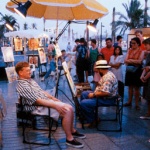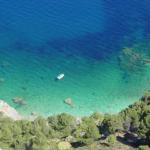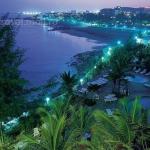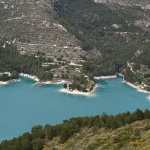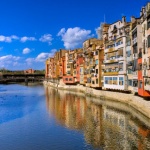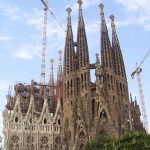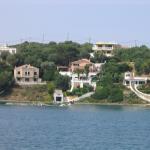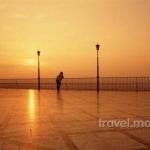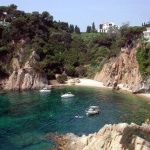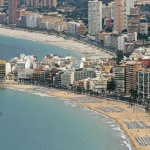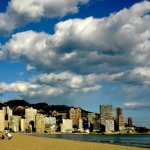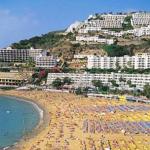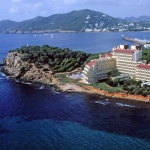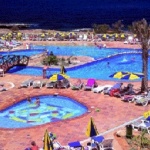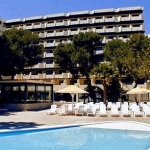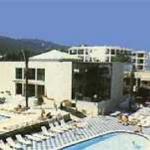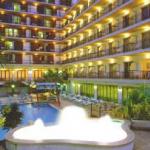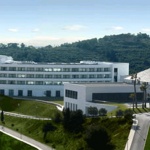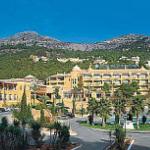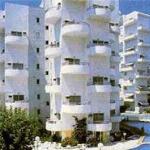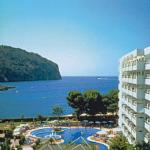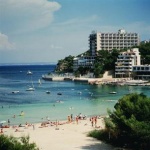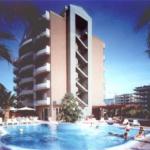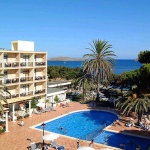Spain Sights
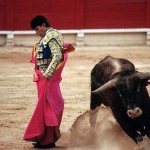 Practically the whole of Spain is a great historical museum under the open sky, surrounded by a ring of beautiful sea coast and resort areas, many of which are considered the best in Europe.
Practically the whole of Spain is a great historical museum under the open sky, surrounded by a ring of beautiful sea coast and resort areas, many of which are considered the best in Europe.Madrid is situated in the heart of the Iberian Peninsula, in the heart of the Castilian plateau at an altitude of 646 meters above sea level. The city was founded during the reign of Emir Mohamed I (856-886 gg.), Who ordered to build a fortress on the left bank of the River Manzanares. For a long time Christian and Muslim countries fought for the ownership of this fortress, which was reflected on the unique shape of the capital. The historical legacy of Madrid is huge. By tradition, the city center is loschad Puerta del Sol with three statues and the old Post House (1768), topped the clock with four dials, under the bell which the residents of Madrid celebrate the Lunar New Year. The area is decorated with the symbol of the city - the bear and arbutus. Habsburg District allocated narrow and chaotic streets and crossing a large number of houses and land in the XVII. Framed colonnades of the central square of the Plaza Mayor, served in the Middle Ages as a market square, the place of bullfighting and the burning at the stake. Today, the most notable buildings in the Plaza Mayor is the house baker, whose facade is decorated with frescoes, and the house of the butcher, where currently there are municipal services. In the center of the square stands the equestrian statue of Philip III. The eastern side of the Plaza Mayor is the Plaza de la PROVINCIEN, where the palace of Santa Cruz, in which the Spanish Foreign Ministry. Nearby is the picturesque area of Villa with a beautiful city hall (1640), which met Consistory and was a prison of La Villa. In the nearby medieval streets "scattered" dozens of monasteries and palaces - the Basilica of San Miguel in the Baroque style (XVIII cent.), The palace of the Casa de Cisneros (XVI cent.), The Palace and the Tower Luhanes (XV cent.) Moorish-style ( "Mudejar"), the Monastery Carboneras (1607), the Church of San Pedro el Viejo (XV cent.) with the tower in the style of "Mudejar" XIV century, built on earlier minaret of the mosque. On the square is Flanks Chapel Bishop - the only temple in Madrid in the Gothic style, the altar and the silver doors of which are of great artistic value. Nearby is the area of Los Carros with the chapel of San Isidro in the Baroque style and the area of San Andres, where the baroque church of San Andres. In the area of Marina Espanola located palace Senate (the end of XVI century.), The Palace de Grimaldi (1776) and the monastery Reparadoras (1782), and the same name space - convent Deskalsas-Reales (XVI cent.) With a wonderful collection works of art.
Puerta de Toledo (Toledo Gate) located in one of the oldest quarters of Madrid - La Latina. This area should be visited to see the Basilica of St. Francis of the Grand with an interesting collection of paintings by famous artists, Chapel of Cristo de la Venerable, a small park Vistilyas, a panoramic view west of the city with the country manor on the horizon, above the street Viaduct Segovia Palace of the Dukes de Uceda (1611), which now houses the main Captain and the State Council.
King (East) palace - a remarkable example of the palace arhitektuy XVIII century, surrounded by a park with gardens and Moorish Sabatini field, now it is partially open to the public. Here, in the apartments of the King of Spain the middle of XVIII century, on display furniture, finishes, carpets, sculptures and other works of art. Nearby is the Cathedral of Almudena, and in the complex of the palace - the Royal Arsenal, Royal Museum of Pharmacy and coaches. Bridge of Segovia - the oldest of the bridges (the end of XVI century.) Crossed the River. Manzanares and he can see the beautiful panorama of the Royal Palace and its surrounding gardens.
In the area of Spain are two buildings of 50 years of XX century - the House of Spain and the Tower of Madrid, as well as a monument of national significance - the church of San Marcos (1753) in the Baroque style. Nearby is the Museum Cerralbo immersed in the green palace of the XIX century, has interesting collection of art, as well as the Liria Palace, is the residence of the Duchess of Alba, and Alba House Foundation receptacle with a collection of works by great masters. Behind the palace is located Barracks Conde Duque in the Baroque style, built in 1720, which houses municipal services, as well as exhibition halls and municipal library. Summer in the courtyard hosts concerts and evening performances.
Fountain of the goddess Cibeles, the symbol of the Spanish capital, is located on the square of the same name and surrounded by the most famous monuments of Madrid. Here are the Palace of Communications (1905), Maritime Museum, which stores the interesting documents and models of ships of Spanish Navy, and the Puerta de Alcala on Independence Square. Nearby are the Museum of Decorative Arts, Museum of the Army and the Royal Academy of Language.
In addition, the city can find a lot of different samples of different artistic styles of the XIX and XX centuries. As well as a large number of parks and gardens. Especially good Retiro park, built in the XVII century. a recreation area for the royals. The park covers an area of 150 hectares, which grow more than 15 thousand trees, smashed a wide variety of gardens and built many monuments, notably the Palace of Velázquez and Glass Palace - a huge greenhouse of glass and steel. Botanical Garden was established in the XVII century. by royal decree and is famous for its bars, carved doors and antique orangery in the neoclassical style. The country estate of Casa de Campo is spread over an area of 1,722 hectares on the right bank of the River Manzanares. Here are Zoo and Amusement Park, there is a rowing canal, and other sports facilities - swimming pools and tennis courts.
For lovers of night life of Madrid - a paradise in every season. Around the area of Santa Barbara, in the squares of Bilbao and Alonso Martínez concentrated a large number of popular cafes, eateries, bars and bistros. In the streets of Huertas and Malasanya, between the areas of Bilbao and San Bernardo, an area of Santa Ana and the streets around the square on May 2 are concentrated numerous cafes and bars with musical programs and inexpensive restaurants. In neighborhoods Argüelles and Moncloa are inexpensive bars, mostly popular with students and youth. Castellana Boulevard, Rekoletos and Prado - Areas of expensive restaurants, trendy cafes and bars.
In the vicinity of Madrid are important historical and cultural centers in Spain. San Lorenzo de El Escorial, located in the Guadarrama Mountains, 50 km. from Madrid, is famous for its magnificent palace-monastery Zarzuela, residence of Spanish kings. Church, monastery and palace courtyards are connected by multiple, passages and rooms, forming indescribably picturesque structure. Along the side walls of the basilica are 43 altars with paintings, while the basilica itself is covered with a dome 92 m high with rospisnymi vaults. Here are a library with more than 40 thousand volumes and manuscripts, museum and art museum of architecture. Outside the palace is interesting to visit the little palaces - House of Prince and the Infanta house.
The ancient town of Alcala de Henares (33 km. From Madrid), the birthplace of Cervantes, is famous for its university, founded in 1498 building on the area of the University of San Diego has a magnificent facade in the style of "Plateresque and courtyards (the most famous of which a "Yard of the three languages), picturesque covered galleries, gardens and the old auditorium. The city is also a lot of great monasteries - Church Mahistral (XII century.) Bernardine Monastery, the Church of the Jesuits, the Monastery of the Philippians and the Archbishop's Palace. On the streets of La Imahen located the house where Cervantes was born. He is now restored and furnished with furniture and objects of the relevant period.
Aranjuez on the banks. Tahoe, 47 miles. from Madrid, is famous for its magnificent summer royal residence (XV-XVII century.) and magnificent parks - Ground floor with numerous sculptures, La Isla with wonderful fountains and Principe in the English style. Faluas interesting museum with a collection of boats and two small silver rails, which are preserved in the memory of the opening in 1851, a second rail line in Spain. House Peasant (Kasita del Labrador ") - a hunting pavilion in the neoclassical style in the back of the garden Principe, famous for the fact that it was here in 1805, was signed by the Spanish-French agreement on the war against Great Britain. In the city of Avila (115 kms. From Madrid), perfectly preserved ramparts, the cradle of St. Theresa's Cathedral and the XIV century. City Chinchon (45 km. From Madrid), famous for its beautiful square Real Plaza de Toros. In the vicinity of Chinchona interesting castles Kasasola (XIV century.) Poorly preserved de los Condes, close to the monastery visits Clarissa and former monastery of Augustinian monks, as well as locking in the XV. near the spa Manzanares el Real.
In the capital of Catalonia Barcelona, founded in the II. BC. e., preserved almost intact the entire historical center in the Gothic style, as well as an incredible number of architectural monuments. The main attraction of the city is considered the largest in Catalonia Cathedral of St. Thekla, built on the site of the ancient sanctuary of Jupiter. The building was built in Gothic style in the XIV-XV centuries. unites in a single ensemble, and three more of the palace - the Casa-cases-Kanonzhes, Degas and the Casa de L'Ardiaka.
Old Town - Part Alta - surrounded by the Roman wall, dating from the III century. BC. e. Now, within the old town are the Palace Museum Pretor Roman Empire, a beautiful fountain at the Pla de Palau, and a copy of the famous Roman "wolf", two well-preserved cylindrical towers of the Roman fortress walls and an aqueduct. Gothic Quarter Gothic Barrio is located within the protected walls of the Roman settlement and got its name because of the abundance of monuments in the Gothic style. Within the area there are many architectural monuments - the palace of Real Mayor (XI-XIV centuries.), The chapel of Santa Agata and the Historical Museum on the square Rey, just outside the walls of which are being arheologichesike excavations. At the Plaza San Jaume, the official heart of the city, was the palace of Palau de la Zheneralitat (XV century. Now here posted Catalan government) with patio de los Naranhos and the chapel of San Jordi, the city hall (XIV century .) with a beautiful ceremonial hall Salo de Saint. At the Piazza San Justo constant attention of tourists attracted by the Gothic fountain, the Palace of Moishe (XIII century., The largest private palace of the medieval Barcelona) and the Church of Santos Justo and Pastor. It is worth paying attention to the palace Senteles (XVI cent.), Cal (Jewish quarter), the Church of San North and Church Affairs Pi with rosette window, presumed to be the largest in the world.
Outside of the Gothic Quarter Barcelona "blooms" numerous monuments of all periods and styles - Cathedral of Santa Maria Affairs Mar (XIV century.) Dalmases Palace (XVII century.) Palace of the Marquis de Lio of Textile and Costume Museum, the palace Nadal with the Museum of Pre-Columbian Art, Palace Aguilar (XV cent.) from the Picasso museum, the monastery of San Pere de les PUELLES (945) and the Palace of Catalan Music (1908), introduced by UNESCO in the list of heritage of mankind ".
At the heart of Barcelona's Circuit de Catalunya is the area around which is also a great variety of attractions - Columbus Monument, Barcelona Exhibition Center, the National Palace, the Palace Marset, the famous Casa Mila or house without corners "of Antonio Gaudi, also made the list of World heritage of humanity by UNESCO, the palace Baro de Quadras Roca with the Museum of Music of the Gothic church of La Concepcion and the Church of Las Salesas faced with multi-colored pottery.
One of the symbols of the city is many-towered cathedral Sagrada Familia (Holy Family, "or simply" The Cathedral ") in height 170 m. The construction was initiated by Antonio Gaudi in 1883, but has not yet been completed. However, in the city and many other great works of Gaudi - Palace and Park Güell (declared "heritage of mankind"), home of the Casa Mila, Casa Batlle, House Vicens, etc. La Rambla - a rather traditional name for the Spanish streets, but in Barcelona it still one of the symbols of the city - seven boulevards, distinguished by name and characteristics, but certainly rich entertainers, cafes and restaurants. Closer to the center is the Rambla de Kanaletes with its famous source Kanaletes - tasted its water would return to Barcelona again.
Rambla Affairs-Estudis interesting by the University (Estudio Zheneral "), Church of Bethlehem, a baroque palace Moha (XVII century.), Hospital Santa Cru (" Holy Cross ", XV-XVI centuries.), And poultry markets. Bordered by huge plane trees Rambla de les Flores ( "Boulevard of Flowers") attracts visitors to the palace Virreyna (XVIII cent.), Which is now located Exhibition Center, an excellent market Bokeria and the nearby Theater Grand Theater-affairs-Liceu - one of the most magnificent theaters of the world (restored after a severe fire). At the Rambla de les Kapuchins interested in the college of St. Bonaventure (XVII century.), Which is now located Hotel Oriente, Palace Guel and lights the early work of Gaudí. Rambla de Santa Monica - a more modern and wide street, on it are the Church of St. Monica and Exhibition Hall Arts Center in Santa Monica, and the classical palace March of (XVIII cent.), Where now is a department of Culture of the Government of Catalonia. On Sundays there is open market products of national crafts.
Most of the galleries of the city is in the Eixample district ( "New District"), on the streets Kunsel-de-Seine, Passech de Gracia, Mallorca and Balmes, near the railway station and the streets of France's Petrichol. In the Jewish quarter Cal, in the heart of Barrio Gothic, in the streets of Banes-Nous and de la Paglia, next to the market Enkants, at the intersection of Arago and Dos de Mach, is a large number of antique shops.
In the vicinity are beautiful natural parks - park Monsen (40 km. From Barcelona), declared a UNESCO Biosphere Reserve, park of Sant Llorenç de Munt and Serra d'Obak - a beautiful mountainous terrain with spectacular cliffs and nature preserve protects Font-Grog typical Mediterranean forest of stone pines and oaks.
And in Catalonia, many castles built in the XIII-XIV centuries. Of which are particularly popular in the castle Fortarde Tordera, Peralada castle not far from Figueres, which conducted the famous music festival and make the Spanish sparkling wine. Montserrat (60 km. From Barcelona) is considered the spiritual center of Catalonia, there are the famous Benedictine Monastery of the Basilica of the XVI century., where the stored image of Our Lady of La Moreneta (XII century.), patroness of Catalonia. People come here from all over the world to worship the miraculous Black Madonna, listen to the famous boys' choir or take a foot pilgrimage to the monastery walls. The Benedictine monastery was founded Gifre I, the first head of an independent county, and is considered the "cradle of Catalonia.
Costa Brava (Wild Coast) - Resort stretch of coast, beginning at 40 km. north of Barcelona and stretches around the coast of the province. The mild climate, pure water, wind, Tramuntana, which makes the sky cloudless and bright, beautiful landscapes, the alternation of rocky shores with small coves and beaches with fine sand - all this makes this place one of the best resorts in the country. Playa de Aro is famous not only a golden beach and a public holiday, but also known as a large commercial complex. The resort Pineda de-Map is an international health center "Sport and the sea." Tossa de Mar is located in a cozy rocky bay surrounded by small beaches, cliffs, caves and lagoons, attracting thousands of tourists. Tourist capital of the coast is Lloret de Mar, in lush, famous for its water park Marineland, kartingdromom and botanical garden Marimutra (founded in 1928). Blanes - one of the oldest resorts on the Costa Brava is famous for its botanical gardens, which gathers many exotic plants from all parts of the world, as well as well-preserved to this day medieval monuments and buildings of the old Spanish building. His magnificent bay, surrounded by rocks, has a wide sandy beaches and is ideal for fishing and water sports. Other tourist centers of the region - Rosas, San Pedro Pescador, San Martín de Ampuriyas, La Escala, Estartit, Begur, Spain, Palamos, S'Agaro and Sant Feliu de Giksols.
Costa Dorada (Golden Coast) is also located south of Barcelona. Center of Costa Dorada and the most popular resort in the region - Salou (100 km. South of Barcelona), best known for its amusement park and entertainment complex "Port Aventura" - the second largest in Europe after Disneyland Paris. Such an abundance of theatrical performances, flowering gardens, "Russian hills" (one of them has three "loops", and its height exceeds 60 meters), and other attractions, not even in the World of Disney. "Port Aventura" provides an opportunity for one day "to go" on all continents of the world - are brought to architecture, culture and even the vegetation of Australia, Polynesia, Asia, Mediterranean Europe and America. Each "country" absolutely independent, until the clothes of employees and the original "national" menu in cafes and restaurants.
Lleida province - more than 600 km. clear mountain lakes and rivers, along which are hotels and camping sites for anglers, where you can take equipment and even take a course, it's rough rapids and waterfalls, tortes, many sports centers on the river banks collect and Noguera, where the world championships Water rodeo, acrobatics and freestyle. Landscapes - as in the Grand Canyon, and orange rocks of fantastic shapes crowned with castles.
Lleida, the capital of the province, rises in terraces up the hill, on top of which a grand citadel of the Cathedral (XII-XV cc.) In the center. National Park Aiguis-Tortes - Reserve "turbulent waters" with a capacity of 200 glacial lakes and countless waterfalls, interspersed by small villages, such-as old as the mountains around.
Valencia - the capital of the same name and the third largest city in Spain. The town has preserved a remarkable architectural monuments, among which the most notable Old Market and bell tower of the cathedral Migelete, the famous tower of Serrano, Quartus and others nearby is the picturesque Plaza de la Virgen to the Cathedral of the Blessed Virgin, which is the patroness of Valencia, the magnificent Gothic palace Valencian Government, Modern Central Market and the Pearl Valencian architecture - Fish Market Lonja. On Thursdays at noon there is a weekly meeting of the court of elders - the Water Tribunal, which is considered the most ancient body of democratic self-government in Europe, is one of the most beautiful sights in Spain.
Interesting monumental area Ayuntamento with City Hall, North Station and the Main Post Office, as well as pedestrian zones, the mass of banks, shops and cafes. The ultra modern Palace of Music with amazing acoustics and regularly holds concerts of the best musicians in the world.
In the town of Sagunto (20 km. To the north of Valencia) the remains of ancient fortress with powerful Roman theater era Punic wars - Saguntum. The fortress became famous for the fact that a few months withstood the siege of the troops of Hannibal, as its advocates preferred to surrender the death in battle. No less interesting castle in the charming, ukryvshemsya in the shadow of magnificent sycamore Xativa town 50 km. the south-west of Valencia, on the saddle of the mountain range, offering a strikingly beautiful view of the surrounding valley. Beautiful and majestic mountain landscapes in the area Maestrango bordering the Aragonese province of Teruel. Another attraction is located at 10 km. south of the city, very close to the sea, lake Albufera - the biggest in Spain.
Well-equipped resorts located throughout the 500-mile coast of Valencia. Area Costa de Azahar (orange flavor Beach ") in the north is famous for its resorts Peñíscola, Alkosebre, Oropesa, Benicasim etc. In Costa de Valencia the most famous resorts Balvarosa, Saler, Perelonet, coolers, Gagua and Oliva.
The famous Costa Blanca (White Beach) in the south - one of the major tourist centers of Spain. That's good comfortable beach, with the magnificence melkopeschanymi beaches and numerous hotels and entertainment centers. Famous the world resorts Torrevieja, Denia, Javea, Benidorm, Moraira, Calpe, Santa Pola, Guardamar de Segura, Torre Vyeha and Campoamor. Torrevieja ( "old tower"), except the excellent conditions for recreation, and is famous for its famous festival of "Habanera" in August.
Alicante, just south of Valencia, in the heart of the Costa Blanca, famous for its two large beaches and plenty of Arab stronghold of Santa Barbara on a cliff Benakantil (166 meters) from the walls, which viewed the entire city. The Gothic church Iglesia de Santa Maria (XV-XVI centuries.) Was built near the castle on the site of a Muslim mosque. Nearby is the Museum of Art XX century with an interesting collection of paintings. Cathedral of San Nicolas de Bari was built in 1662, in honor of the patron saint of Alicante and is considered one of the most important historical monuments of the city, but on the opposite end of town lies the castle Castillo de San Fernando (1808-1814 gg.) Over wonderful municipal park.
Benidorm is not only considered one of the most popular holiday destinations in Spain, but also has the title "The tourism phenomenon in Europe - so fast it has evolved from an unknown fishing village into a major tourist complex of the country. The city is spread on the beach Playa de Levante and Playa de Poniente, connecting with a small rock, which is an observation deck with beautiful views. The main place in town - nab a total length of about 6 km. - A turn of a variety of shops and souvenir shops, restaurants, cafes and bars offering traditional dishes of any cuisine in the world. In the center of Benidorm is a huge water amusement park Aqualandia, with swimming pools, water slides and caves.
Altea - a small town 10 km. from Benidorm, perfectly preserved architecture of yore. Most Altea boasts numerous art galleries, artists' colony and rocky beaches, and in the evening - many café tables on the Cathedral Square and friendly lights for more than 30 restaurants and bars.
Calpe is located approximately 12 km. to Althea foot jutting out into the sea mountain Ifach height of about 300 m., an old lookout tower on top of which is a kind of symbol of the Costa Blanca. At the foot of the hill is a protected park area, which presents more than 300 species of plants, among which you can see unusual carnations and orchids.
The spa Hawa - one of the oldest cities of the Iberian coast, is located approximately 27 km. to the north of Calpe. The city is situated between two capes - Nao and San Antonio and is known for its excellent conditions for a quiet and peaceful family holidays, as well as their original church - an unusual church in the XV. in the Gothic style, and modern church in the form of a ship. Historical and Ethnographic Museum Havei offers an interesting collection of objects from the Paleolithic to Moorish period, as well as products made of ceramics of different periods. Denia is located 10 km. from Javea. Here are preserved walls and towers of the castle, built by the Moors (now there is the Archaeological Museum), and on to the Plaza de Constitución stands the church, XVIII century. Denia is located near the water park, Safari Park, famous for its "dolphin show.
Region of Murcia, located between Valencia and Andalusia, known for its fruit and vegetables, and its coast - another tourist area of Spain. Cartagena, founded by the Carthaginians as early as 221 BC. e., and still retains its value. Its architectural monuments bear the imprint of many svoebrazny ages, "swept" through the city, and the Museum of Cartagena has a great collection of Roman and Iberian subjects, indicating an important historical role of cities in antiquity. The resort area of Costa Calida has a mild climate and beautiful beaches with fine sand. Here is located a salt lake of Mar Menor, linking the Mediterranean Sea - the perfect place for water sports. The most important tourist centers - Santiago de la Ribera, Manga del Mar Menor, Puerto de Mazarron, Aguilas and Cartagena itself.
Andalusia - southern region of Spain, where there are well-preserved to this day monuments - the medieval fortress and the Arab tower XI century, cathedrals and ancient settlements in the Andalusian mountains. Here is the warmest sea, the hottest and longest summer (3000 hours of sunshine per year), attractive landscapes and numerous bullfighting arena. Andalusia is the birthplace of flamenco and a special style "Sevillano".
The capital of Andalusia Seville - an extremely original city on the banks of the Guadalquivir. Large impression the former Jewish quarter of Santa Cruz, an ancient Arab fortress Alcazar (1350-1369 gg.), 93-meter minaret is the square of the Arab mosques Giralda (XII century.), Which was transformed into a magnificent Gothic cathedral bell tower, Torre Del Oro - the ancient stronghold of the Arab city wall, the monastery of Santa Maria de las Cuevas, where Columbus was originally buried, and Discovery Park on the island Kartuha. Seville Cathedral (1402-1506 gg., 116 meters in length, 76 meters wide), built on the former site of the mosque is the third largest Christian cathedral in the world. Located in the walls of the cathedral archives of America (formerly the Archives Indies ") contains about 36 thousand folders with documents on the discovery and conquest of the New World, gathered since 1785
Maria-Louise and Piazza di Spagna - the symbols of the city. Piazza di Spagna is surrounded by a number of arches, which are crowned with emblems of all the provinces of Spain. In the beautiful buildings around the square now has a military and civil administration. Palace House of Pilate "(XVI cent.) Named after the biblical procurator and built with the repetition of certain elements of his home in Jerusalem. His filigree architecture reflects a mixture of styles "Mudejar" with elements of the Renaissance, represented remarkable tiles and moldings. Nearby, in the building of the former convent houses the Museum of Fine Arts. "Magic Island" - the world's first theme park, located directly in the city, in its historical part. In addition to the attractions given the opportunity to become acquainted with the history, culture and art of different times and peoples enjoy a water show, a ride on a high-speed roller coaster, and during lunch or dinner to listen to the exotic songs performed by numerous musical groups. The park is open ultramodern planetarium, funicular, monorail, a large concert hall and hosts various entertainment events - from laser shows to concerts of flamenco and rock.
Great Granada is situated at the foothills of the Sierra Nevada. In the Middle Ages it was the center of the last and most long-existing Muslim state in Spain. In the old quarter Albasin was the first Moorish fortress, here was the last refuge of the Moors, when the Christians took the city by storm.
Fortress of the Alhambra (Al Kal'a al Hambro "-" Red Fortress ") - the only surviving monument of the artistic art of the Moors in Granada, situated on a steep ridge above the wooded hill. Considered one of the wonders of the world, artfully decorated castle represents the top of Moorish art and culture. Center court life in the Alhambra were the "Yard of lions" (28 pm to 15 pm) with a fountain in the center of which rests on the backs of 12 small lions of gray marble, and Courtyard myrtle "- open area (110 m by 78 m .) with a narrow pool, which is surrounded by bushes and myrtles. At each end of the courtyard are decorated with niches with arches, and at the northern tip of the courtyard is "Hall of Ambassadors" - Reception Moorish rulers. All this magnificence completes the dome of cedar wood. To the north of the "Hall of Ambassadors" lies "Hall of Two Sisters" with the most graceful in Alhambra vault in the form of a honeycomb - argue that it consists of 5 thousand cells. On the walls of Moorish fortress La Alcazaba (IX cent.) Offering breathtaking views of the palace, areas Heneralife, Albaysin, Sacromonte and the Sierra Nevada.
Close to the Alhambra, and towering above it, and over the town, there is an old summer palace of the sultans, with many pools and fountains - Heneralife (1250). In the period between 1506 and 1521 years. Here was built the Royal Chapel, which now lie the remains of many Spanish kings of the past, displayed the royal regalia, and in the sacristy of the chapel contains many works from the private collection of Queen Isabella, including Flemish, Spanish and Italian artists of the XV century. Baroque cathedral (1523-1714 gg.) Adjacent to the Royal Chapel and the intricate and surprising bezvkustnym view. To the east of the Royal Chapel are tiered gardens and a wonderful portal tower Dame. In Fuente Vakeros, where Lorca was born, now a museum, is also open and Huerta de San Vicente - the old farm in the outskirts of Granada, where Lorca wrote several famous works.
The first mention of Cordoba refers to the year 206, but "blossomed" when she Arabs - are wonderfully combines Arabic, Jewish and Christian styles: the palace of the caliphs, beautifully landscaped gardens with fountains, an Arab mosque Mesquita (785-985 gg.) - The second largest after Mecca, converted later to the Church of the Assumption, a Roman bridge, the Jewish quarter, "El Cristo de los Faroles" - a crucifix, which stands for completely closed on all sides by the square, and the Archaeological Museum (the world's largest collection of lead sarcophagi and capitals) in the palace Jeronimo Pass. About 8 km. to the north-west of Cordoba, in the Old Cordova, preserved remains of the vast palace complex Medina Asahara (about 936).
Malaga - a friendly town on the southern coast. Above the city rises the majestic fortress of La Alcazaba, Cathedral of interest (XVI cent.) And its treasures, Area Bykov and Gibraltar Castle. Nerja, which lies at the foothills of Sierra de Almiharra, interesting prehistoric caves with halls and galleries. In Cártama, 25 km. from Malaga, is "Kokodriles Park, in which more than 300 live reptiles in a specially re-establishment of local natural habitats.
Costa del Sol around Malaga - one of the most important tourist areas of Spain, with the famous resorts of Marbella, Torremolinos, Kalaonda, Torre del Mar, El Polo, Benalmadena, Benalmadena Costa, Fuengirola, San Pedro de Alcantara and Estepona.
Castile and Leon - a vast region located on a vast plateau meseta, interesting beautiful scenery and brilliant historical and monumental heritage.
In Segovia, except the Roman aqueduct, there are many other monuments of different ages - some magnificent Romanesque churches, a large Gothic cathedral and the amazing fortress of Alcazar Arab origin. Avila - Homeland Teresa de Jesús, in an excellent position to keep the medieval ramparts, a powerful military fortifications and Romanesque basilica of San Vicente, built directly into walls. Soria particularly distinguished Romanesque buildings of Santo Domingo Church and Convent of San Juan de Duero (XII-XIII cc.). Homeland Cid - Burgos, no less notable for its Gothic cathedral, the exceptional beauty (one of the best in Spain), magnificent churches and palaces in the old part of town. Palencia is a distinct medieval character, with a beautiful cathedral in the late Gothic style and remarkable archaeological museum.
Valladolid - the capital and largest city in the region, famous for its gardens and cathedral-style Plateresque, College of Santa Cruz and San Gregorio, as well as the Museum of Sculpture with an excellent collection of the leading sculptors of Spain XVI-XVII centuries.
Leon - the ancient capital of the kingdom of the same name, has three outstanding monument - the Church of San Isidoro (XII cent.) With a crypt decorated with Romanesque frescoes, Gothic church with many stained glass windows, which can be rivaled only by stained glass windows in Chartres Cathedral and the old Convent of San Marcos - a magnificent structure of the Renaissance, now converted into a tourist Parador higher category. Salamanca was famous already in the Renaissance, its university - one of the first in Europe. Now the city is famous for its beautiful Romanesque and Gothic soboramm, the picturesque main square with arcades and the building of the University of the Renaissance.
Canary Islands - an autonomous region of Spain, located in the Atlantic Ocean in 1500 km. from the Iberian Peninsula and 100 km. the coast of Africa. The islands are of volcanic origin, but each island is very different from the next, so there is remarkably diverse landscapes, a lot of green valleys, beautiful mountains, bizarre lava forms and many beautiful beaches. Islands are unique climatic conditions, their flora and fauna are extremely diverse and have kept a number of relict plant. Thanks to constant trade winds, the weather on the islands has always supportive and in no way inferior to the famous Hawaii.
Tenerife - the largest (2 ths. Kms.) And the most popular tourist island in the archipelago. There is a national park Cañadas del Teide, located at the snow-covered peaks, the Teide - Spain's highest mountain (3718 m). This is one of the most interesting places of the country - an extinct volcano located inside another of the ancient crater with a diameter of 9 km., On top of which can be podyatsya by cable car or travel by jeep. Here, among the fantastic "lunar landscape" and colorful lava fields, many movies were filmed in a series of "Star Wars". In the north of the island, in the Botanical Garden Valley Orotava (founded in 1788), we can see nature at once five climatic zones, there is a monument of national importance - the ancient city of Orotava, beaches and popular resorts of Puerto de la Cruz, Los Cristianos and Playa de las Americas, as well as Chinamada village in the mountains of Anaga with carved into the cliffs dwelling caves. In the south of the island is always sunny and dry, ancient lava fields shimmer with rainbow colors, and the vegetation framing the famous beaches, the desert. The best beaches are located north of Santa Cruz de Tenerife - the capital of Tenerife. Fine sand in a protected artificial reef bay of Playa de las Teresitas was brought here from the Sahara. County of El Medano - the best place for windsurfing. Very picturesque small sandy cove near Playa de las Americas, as well as the Lido de San Telmo. In Laura Park, near Puerto de la Cruz is the world's largest colony of parrots (about 230 species) and a giant aquarium.
In the center of the island of Gran Canaria mountains rise to 1950 meters in height, and dry and hot South is an endless resorts - San Agustin, Playa del Ingles and Maspalomas, overlooking the beach of Maspalomas dyunny included in the list of 100 best beaches in the world . Multi-colored house fronts the island's capital - Las Palmas, turn the town into a veritable kaleidoscope, and its Museum of Columbus (a former Governor's House) attracts lovers of history here. In the town of Teror necessarily go for the sake of the beautiful local beaches, water parks and excellent conditions for shnorkelinga.
Lanzarote - the fourth largest island of the archipelago - the result of joint action of nature and the artist Cesar Monrike, turn the island into his workshop. The brightest sight Lanzarote - Mount Fuego ( "Fire") in the National Park Timanfayya, whose valleys covered with multi-colored volcanic ash and surrounded by black obsidian waste land. Monrike "a hand" and to the famous cave Hameos del Agua, which the sculptor has turned into a symbol of living here a unique "blind crab", a cave, Cueva de los Verdos he filled with the sounds of music and fantastic illumination. Both cave - part of a giant tunnel, lava punctured about 5 thousand years ago, originating in the crater and going somewhere in the ocean. Beautiful white house Mosagi, yellow sand of the famous beach of Papagayo and an observation deck Mirador del Rio. Best resorts of the island - Playa Blanca, Puerto Calero, Puerto del Carmen and Playa Teguise, Las Palmas.
Fuerteventura ( "strong wind") - yet least known island in the Canary archipelago. More than half of the island fringed by magnificent beaches of white or golden sand, including the famous Playa de Corralejo. It is interesting to visit the capital and main port of the island - Puerto del Rosario, windmills Antigua and villages in La Oliva, Pahari and Betancourt, the arena "Terrero" in Tarahaleho and competitions in traditional combat in the sand. Every year in July and August there is the world championship in windsurfing, and the strait between the Lobos and Fuerteventura is the best place for diving in the islands.
Balearic Islands, consisting of five islands - Mallorca, Menorca, Ibiza (Ibiza or Ibiza), Formentera and Cabrera are in the Mediterranean Sea about 240 km. to the east of the coast of Valencia. Thanks to its climate, beautiful beaches and a developed tourist area, the archipelago has become the most prestigious and attractive holiday destination on the Mediterranean. Palma de Mallorca (Palma) - the capital of the archipelago and one of the largest ports in the Mediterranean. The city has many monuments - Bellver Castle (XIV century.) Rare round, the Gothic cathedral, the old commercial exchange, and the Archbishop's Palace. Along the coast stretching first-class beaches of Palma Nova, Can-Pastilla, etc. (the length of a coastline of 554 km.!). Mahon, the capital of Menorca, is attractive to its picturesque port city hall and the church of Santa Maria and San Francisco. Ciudadela, the former capital of Menorca, - a small, picturesque town with magnificent palaces and medieval churches. Ibiza (Ibiza or Ibiza) - the capital island of the same name and known for its easy virtue of the youth resort, famous for its peculiar quarters, a stratagem which even gave rise to the concept of "architecture IBIS. Above the city stands the medieval fortress, and not far from it, in Puig des Molins, is an ancient Punic cemetery. And, of course - beaches, beaches and more beaches again.
